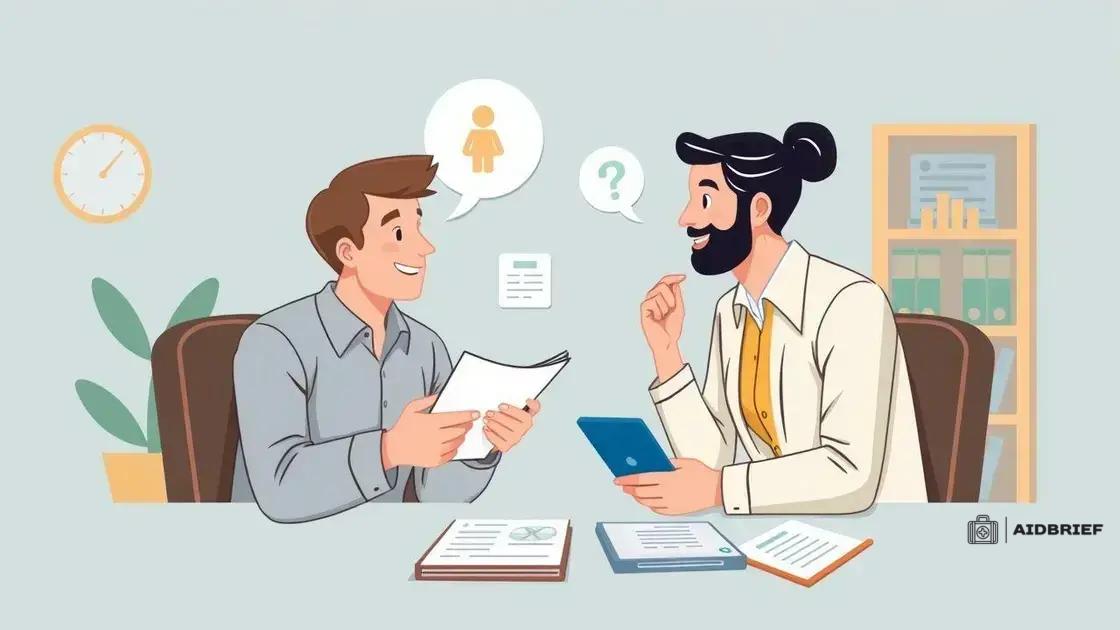Debt collection policy reforms in 2025: what to expect

Debt collection policy reforms in 2025 will enhance consumer protections, promote ethical practices, and leverage technology for better communication, creating a more balanced financial landscape for both consumers and creditors.
Debt collection policy reforms in 2025 are set to reshape the way financial institutions handle collections. These upcoming changes promise to bring more fairness and transparency. Have you thought about how this might change your experience as a consumer?
Understanding the current debt collection landscape
The current debt collection landscape is complex and evolving. With changes in regulations and consumer rights, it’s essential to understand how these factors play a role in debt collection.
Key Aspects of the Debt Collection Landscape
Debt collection practices are influenced by various elements, including laws, technology, and consumer behavior. As the economy shifts, so do the strategies used by debt collectors.
1. Legal Regulations
Understanding the legal regulations governing debt collection is crucial. These laws are designed to protect consumers from abusive practices. Some important regulations include:
- The Fair Debt Collection Practices Act (FDCPA)
- State-specific regulations
- Recent changes in consumer protection laws
It’s important for both consumers and collectors to stay informed about these regulations to ensure compliance and fairness.
2. Technological Advancements
With technology evolving, debt collection methods are also changing. Collectors are now using digital platforms to reach consumers more effectively. This includes:
- Automated calls and texts
- Online payment options
- Use of social media for communication
These advancements allow for quicker communication but require consumers to be mindful of their privacy.
Understanding the debt collection landscape also entails recognizing the role of consumer behavior. Many individuals are more aware of their rights and are informed about debt collection. This growing awareness encourages transparent and fair practices.
Overall, the debt collection environment is dynamic and requires ongoing adaptation from all parties involved. Staying informed about regulations and technological changes is key to navigating this landscape effectively. As the landscape shifts, pursuing better practices benefits everyone involved, fostering a healthier financial ecosystem.
Key reforms proposed for 2025
The key reforms proposed for 2025 aim to reshape the debt collection process significantly. These reforms seek to create a more transparent and consumer-friendly environment. As we look ahead, understanding these proposed changes will be crucial for both consumers and creditors.
Enhancing Consumer Protections
One of the most notable reforms focuses on enhancing consumer protections. This includes:
- Limiting communication hours for debt collectors
- Improving the disclosure of debt information
- Strengthening provisions against harassment
By implementing these changes, consumers will have more control over how and when they are contacted, reducing unwanted stress associated with debt collection.
New Technology Regulations
As technology plays a larger role in debt collection, new regulations will address how this technology can be utilized responsibly. Collectors may be required to:
- Obtain consent before using automated calls
- Ensure data security and privacy for consumers
- Provide clear options for communicating through digital channels
This shift towards technology regulation aims to protect consumer rights while allowing collectors to communicate effectively.
Furthermore, as these reforms take shape, there will be an emphasis on consumer education. Both consumers and collectors will need to understand their rights and responsibilities clearly. Educational initiatives may include workshops and online resources to help individuals navigate the changes confidently.
Overall, the proposed reforms for 2025 indicate a significant shift towards a more balanced approach to debt collection. By prioritizing consumer rights and leveraging technology responsibly, all parties involved can benefit from a fairer process.
Impact of reforms on consumers and creditors

The impact of reforms on consumers and creditors in 2025 will be significant and multifaceted. These changes aim to create a more balanced environment for all parties involved in debt collection. Understanding how these reforms affect each group is crucial for navigating the new landscape.
Effects on Consumers
For consumers, the reforms are designed to offer better protections and rights. This includes:
- Reduced harassment through stricter communication guidelines
- Greater transparency in debt disclosures
- Improved access to dispute resolutions
These protective measures empower consumers, ensuring they are treated fairly. They can expect clearer communication and a reduction in stress related to debt collection.
Effects on Creditors
On the other hand, creditors will also face changes that affect how they operate. These may include:
- Increased compliance costs due to new regulations
- Mandatory training for staff on consumer protection laws
- Potential penalties for non-compliance
While these changes may pose challenges, they also encourage creditors to adopt fair practices. Ultimately, this may improve their reputation and customer relations.
The relationship between consumers and creditors may evolve as these reforms take effect. With a focus on ethical practices and mutual respect, both sides can benefit. Consumers will have more confidence when engaging with creditors, while creditors may see a boost in goodwill and trust.
In light of the upcoming reforms, both consumers and creditors should prepare to embrace these changes. By understanding the impact of reforms, they can adapt their strategies and expectations accordingly. As discussions around these reforms grow, awareness will foster a more collaborative approach to debt collection, benefitting everyone involved.
Best practices for compliance with new regulations
Understanding the best practices for compliance with new regulations is essential for both consumers and creditors in the evolving debt collection landscape. These practices help ensure that entities adhere to legal requirements while maintaining ethical standards.
Adhering to Legal Requirements
First, staying informed about the latest laws is critical. Organizations should:
- Regularly update their compliance manuals
- Attend workshops and training sessions on new regulations
- Consult legal experts when needed
This proactive approach helps prevent potential legal issues and fosters a culture of compliance within the organization.
Implementing Effective Training Programs
Training staff on new regulations is a key component of compliance. It’s important to provide:
- Regular training sessions focusing on consumer rights
- Guidelines on ethical communication
- Updates on technological tools that assist compliance
This ensures that all employees understand their roles in adhering to regulations and can act accordingly.
Moreover, adopting technology that supports compliance can streamline processes. Tools that automate tracking and reporting can significantly reduce the risk of errors. Keeping records accurate and accessible is vital for both consumers and creditors.
Feedback mechanisms should also be in place. Establishing channels for consumers to voice concerns allows organizations to address issues promptly and improve their practices over time. This not only fosters trust but also enhances the organization’s reputation.
By integrating these best practices into daily operations, organizations will better navigate the changing landscape of debt collection. Compliance is not just about following rules; it’s about building relationships based on respect and accountability.
Future trends in debt collection policies
Future trends in debt collection policies are expected to bring significant changes that will shape how creditors interact with consumers. As the landscape evolves, several key trends are emerging that could redefine the dynamics of debt collection.
Increased Digital Engagement
One major trend is the shift towards increased digital engagement. Creditors are investing in digital channels to communicate effectively with consumers. This includes:
- Utilizing mobile apps for payment reminders
- Employing chatbots for customer service interactions
- Incorporating social media for outreach
This trend allows for more instantaneous and accessible communication, making it easier for consumers to stay informed about their debts.
More Focus on Consumer Experience
Another important trend is the growing emphasis on consumer experience. Organizations are starting to realize that building strong relationships with consumers is key. This can lead to:
- Personalized communication strategies
- Flexible payment options tailored to individual needs
- Enhanced customer support during the repayment process
By focusing on the consumer perspective, creditors can improve satisfaction and foster loyalty.
Additionally, there is a rising awareness of fair practices within the industry. Many companies are taking proactive steps to align their policies with ethical standards. This includes adhering to regulations and providing transparency in debt collection practices.
As regulations continue to evolve, it’s likely that more organizations will adopt comprehensive compliance programs. These will not only help them adhere to legal requirements but also bolster their reputations as trustworthy lenders.
In summary, the future of debt collection policies will likely revolve around technological advancements, improved consumer experiences, and a commitment to ethical practices. Staying ahead of these trends will be essential for creditors aiming to maintain a competitive edge in the industry.
FAQ – Frequently Asked Questions about Debt Collection Policy Reforms
What are the expected changes in debt collection policies in 2025?
The upcoming changes focus on transparency, consumer protection, and the use of technology to improve communication.
How will these reforms impact consumers?
Consumers will benefit from better protections against harassment, clearer debt communication, and more accessible payment options.
What challenges may creditors face with new regulations?
Creditors may need to invest in compliance training, update their technology, and adapt their communication strategies to meet new standards.
What role does technology play in future debt collection practices?
Technology will enhance communication through digital channels, automate processes, and help maintain compliance with new regulations.





